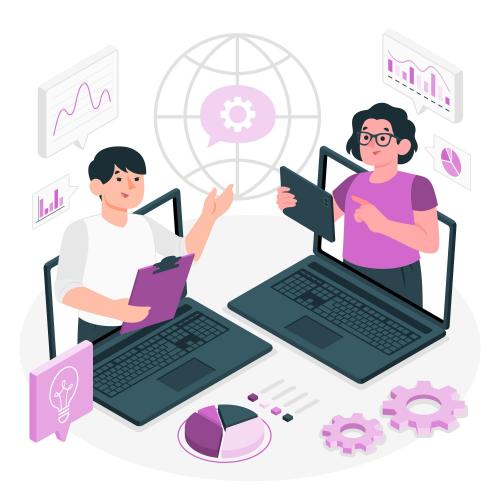Choosing the Best Data Migration Solutions for Your Business

Data is the lifeblood of any business. As technology evolves and business needs change, companies often must migrate their data from one system to another. Proper data migration is crucial, whether upgrading to new software, moving to the cloud, merging with another company, or decommissioning legacy systems. Done wrong, it can lead to lost or corrupted data that harms productivity and costs money to recover from. Done right, it allows seamless transition between systems so business can continue without disruption.
This blog is here to help you choose the best data migration solutions for your specific business needs. We'll cover the different types of data migration and important factors to consider and recommend some top tools on the market. By the end, you'll have a clear understanding of your options and be able to make an informed choice for handling your next data move.
Understanding the Types of Data Migration
Depending on the systems you're moving between, data migration projects fall into a few main categories. Knowing the type helps determine the best approach.
On-Premises to Cloud Migration
Suppose you're transitioning from databases and servers on your company's premises to cloud-based infrastructure like Amazon Web Services (AWS) or Microsoft Azure. In that case, this is considered an on-premises to cloud migration. The cloud offers scalability, flexibility, and reduced maintenance costs compared to on-site hardware. Moving to the cloud properly ensures your critical data safely makes the journey.
On-Premises to On-Premises Migration
Sometimes, companies upgrade their on-site systems without involving cloud services at all. This can include moving to a new version of the same database, replacing end-of-life servers, or combining infrastructures after a merger. On-prem to on-prem migrations involve transporting data between internal storage locations.
Legacy System Decommissioning
As outdated "legacy" systems near or pass end-of-life, their data often needs migrating to a replacement platform. This process extracts information from older databases, mainframes, or custom-built apps to repurpose it on modern software and prevent loss.
Cloud-to-Cloud Migration
If you began in the cloud but want to
switch providers or consolidate certain workloads, cloud-to-cloud data
migration extracts information from one cloud vendor to reload on another, like
AWS to Azure. It gives companies deployment flexibility between services.
Factors to Consider When Choosing a Data Migration Solution
Now that the major categories are clear let's dive into factors that influence which specific data migration tools and methods fit your project best:
· Legacy System Complexity - Older formats may require more data parsing capability than simple structured data.
· Security Requirements - Does your data classification level demand advanced encryption, audit trails, etc?
· Target Infrastructure - Public cloud, private cloud, on-premise? Tools vary in deployment flexibility.
· Skill Level - Do you have in-house migration expertise or need a managed service vendor to handle it?
· Post-Migration Needs - Do you need data transformation, reporting or onboarding services afterwards?
Considering these key factors unique to your situation makes it much easier to evaluate different migration solutions based on features instead of just options alone. The right fit depends on your specific project needs and constraints.
Popular Data Migration Tools to Consider
With so many migration tools on the market, how do you narrow it down to the most suitable options? Here are several top solutions commonly used across different migration scenarios:
Azure Database Migration Service
Microsoft's cloud-based managed service handles migrating databases like SQL Server, MySQL, PostgreSQL, and Oracle to Azure. It automatically detects and migrates schema and data with little downtime. It is easy to set up and monitor migrations in the cloud. It is good for small to large on-prem or cloud data moves.
AWS Database Migration Service
The AWS equivalent offers similar database migration capabilities focused on moving workloads into and between AWS infrastructure. It supports many commercial and open-source database platforms. It has also expanded to migrate non-relational NoSQL data stores like MongoDB and DynamoDB.
Attunity Replicate
A versatile data replication tool that can migrate transactional and non-transactional data between on-premises and cloud, as well as between cloud platforms. It supports many databases, file formats, and significant data sources. It is often deployed for complex legacy to modern migration projects.
Snowflake Data Migration Tool
Snowflake's cloud data warehouse offers built-in utilities for quickly loading data from cloud storage or other databases. It is suitable for consolidating multiple data sources into a single analytics platform in the cloud or on-premises private cloud.
SQL Server Migration Assistant
Microsoft's free migration assessment scanner checks for compatibility issues before migrating SQL Server databases to a newer version. It also identifies potential blocking factors and reports on differences that require addressing.
Oracle SQL Developer Data Modeler
For Oracle database migrations, this visual data modelling tool analyses schemas, builds mappings and generates DDL scripts to swiftly migrate metadata and data between versions and instances. Supports replication as well.
CDC (Change Data Capture) Tools
Components like Attunity Change Data Capture automate replicating changes in transactional systems in near real time. They extract inserted, updated and deleted data change logs, which help maintain data integrations during a migration.
Data Migration Experts
Beyond the tools themselves, full-service professional services are also available to implement, manage and optimize your migration projects for you. Companies like Anthropic, Informatica, and IBM offer managed services and consulting for data migration.
Additional Considerations for Successful Data Migration
Choosing and implementing the correct technical tools is just one piece of the data migration puzzle. There are also "soft" factors behind a well-planned initiative that demands attention:
· Change Management- Data migration causes disruption, and employees need training on new systems and processes. Make the transition painless with communication, documentation and testing/feedback cycles.
· Data Validation- Build validation rules and perform sample migrations to verify data quality, integrity and structure before full deployment. Resolve issues proactively.
· Backup and Recovery—Have redundant backups in case of migration errors. Plan rollback procedures to restore the previous state if needed. Test restore processes.
· Archiving Old Systems- Determine how and when to archive/purge data or demolish old systems once migration concludes to avoid dual maintenance costs and confusion.
· Documentation- Capture all decisions, design diagrams, configurations, schedules and more in centralized documents. It institutionalizes knowledge for migrations today plus any future ones as well.
·
User Training and Support- Ensure
employees are prepared for changes through training modules, help links/FAQs,
videos or in-person sessions. Promote two-way feedback for post-migration
support.
Putting It All Together - A Sample Data Migration Project Plan
With the necessary background covered, let's put together an example data migration plan for an e-commerce business moving from their on-premises Microsoft SQL and IIS web servers to AWS-hosted applications:
- Discovery Phase (2 weeks)
- Interview stakeholders and map current systems
- Inventory all data sources, structures, volumes
- Assess AWS target architecture and replication needs
- Choose a migration tool (AWS DMS for databases, FTP for files)
- Planning Phase (2 weeks)
- Create a high-level schedule and critical path
- Develop validation rules and test plans
- Draft user guide, training materials
- Build AWS target instances
- Development Phase (4 weeks)
- Configure migration tool mappings/filters
- Develop ETL processes for transformations
- Implement CDC replication for transactional data
- Perform sample migrations and validate output
- Migration Phase (4 weeks)
- Migrate databases files incrementally on weekends
- Monitor and address errors daily stand-ups
- Replicate live transactions during the week
- Switch routes/connections to new systems
- Validation Phase (1 week)
- Validate all business rules met
- Compare source/target for accuracy
- Run reports and generate metrics
- Schedule cleanup of legacy systems
- Closeout Phase (2 weeks)
- Deploy training and communications
- Monitor production, address support tickets
- Archive documents, update diagrams
- Declare migration complete
Conclusion
Properly managing data migrations is crucial for any business relying on technology. A poorly executed move can easily disrupt operations and cost time and money to recover from. By considering your unique needs and constraints and taking strategic precautions, you can make migrations a smooth transition. However, handling large initiatives entirely in-house often requires more resources. It is where partnering with a specialized provider like ioMoVo can help.
ioMoVo offers managed migration services that take care of planning to validation. Their certified experts have tools to migrate all types of structured and unstructured data rapidly. IoMoVo's scalable approach helps businesses migrate confidently without adding strain. Their flexible services are worth considering for your next data migration project.







Comments